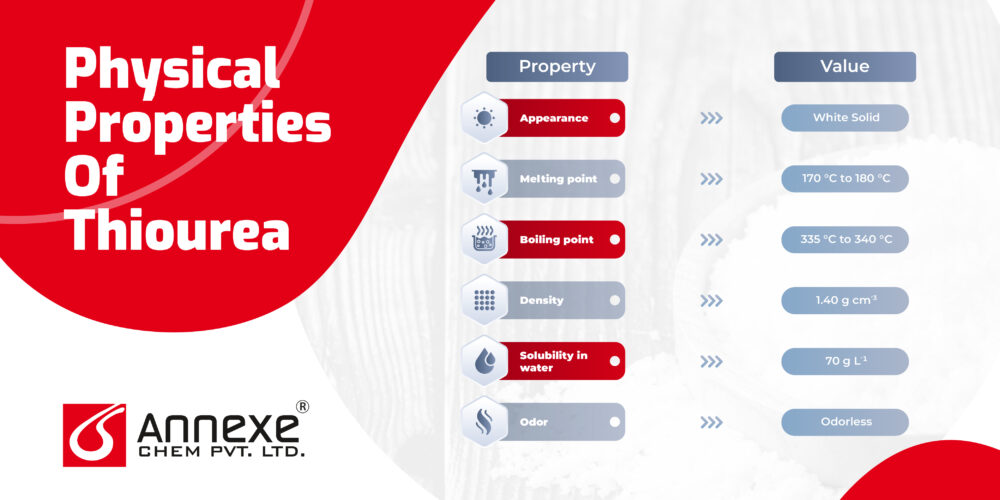Thiourea: Unraveling Its Diverse Applications - Annexe Chem Pvt Ltd
Thiourea: Unraveling Its Diverse Applications

- January 24, 2024
- By Akshita Patel
Thiourea is an organosulfur compound with the formula SC(NH₂)₂ and the structure H₂N−C−NH₂. The sulfur atom replaces the oxygen atom in urea, giving it a structural similarity to urea. Thiourea is also known as thiocarbamide. It is a versatile compound with numerous applications across diverse fields. From its foundational role in chemistry to its pivotal position as a catalyst and medicinal agent, Thiourea has emerged as a subject of immense interest and innovation. Before you go and ask a supplier to provide you with this chemical, It’s essential to know some important facts about it.
What is Thiourea?
Thiourea is a sulfur-containing organic compound characterized by the thiocarbonyl functional group (-CS(NH2)2). Its chemical name is CH4N2S, and its systematic name is thiocarbamide. The sulfur atom in thiourea replaces the oxygen atom in urea. This substitution imparts unique properties to Thiourea, making it a compound of significant interest in various scientific and industrial applications.
One notable feature of Thiourea is its ability to form stable complexes with metal ions, leading to its widespread use as a chelating agent in analytical chemistry and metal extraction processes. Additionally, Thiourea serves as a precursor in diverse organic compounds, including pharmaceuticals and agricultural chemicals. Its versatile nature extends to its application as a catalyst in various chemical reactions. Despite its importance, Thiourea has also raised concerns due to its potential toxicity, and ongoing research seeks to address these issues while exploring new avenues for its beneficial utilization in different fields.
Chemical and Physical Properties of Thiourea
Thiourea possesses distinctive chemical and Physical properties because of its unique molecular structure, which includes a thiocarbonyl functional group.
Chemical properties of Thiourea:
- Metal Complex Formation: One of the significant characteristics of Thiourea is its ability to form stable complexes with metal ions. These complexes have diverse applications, particularly in analytical chemistry, where Thiourea acts as a chelating agent for separating and identifying metal ions.
- Reduction and Oxidation Reactions: Thiourea can participate in reduction and oxidation reactions. It can be oxidized to form diimide, and under certain conditions, it can act as a reducing agent in reactions involving metals.
- Catalytic Properties: Thiourea exhibits catalytic properties, particularly in organic synthesis. It catalyzes various reactions, including the Biginelli reaction and the synthesis of heterocyclic compounds.
- Solubility: Thiourea is highly soluble in water, and its solubility properties make it suitable for use in aqueous solutions in various chemical processes.
- Isomerization Reactions: Thiourea can participate in isomerization reactions, particularly in the isomerization of certain organic compounds.
- Hydrolysis: In the presence of acids or bases, Thiourea undergoes hydrolysis to produce ammonia and carbon dioxide.
- Toxicity: It’s essential to note that while Thiourea has valuable applications, its toxicity can be a concern. Precautions are mandatory when exposed to high concentrations of Thiourea in handling this compound.
Understanding these chemical properties allows scientists and researchers to harness the potential of Thiourea in various fields while considering its reactivity and potential risks.

Applications of Thiourea
Since its discovery, this compound has garnered significant attention and employment due to its unique chemical properties and reactivity. Originally introduced into the market in the early 20th century, thiourea has evolved from a chemical of academic interest to a critical component in various industrial processes. It has been used widely in diverse industries.
- Metal Extraction and Mining: The mineral thiourea plays a crucial role in precious metals extraction from their ore, such as gold and silver. By forming stable complexes with metal ions, thiourea facilitates efficient separation and recovery of valuable metals during mining and metallurgical processes. This method offers an environmentally conscious alternative to traditional extraction methods like cyanide leaching.
- Photography: In photography, thiourea serves as a crucial fixing agent in photographic developers. Its role is to stabilize the developed image by effectively removing excess silver halide from the photographic emulsion. It ensures the clarity and permanence of the photographic image, contributing to the overall quality of photographic prints.
- Textile Industry: The textile industry harnesses thiourea as a versatile reducing agent in the discharge printing of dyes on fabrics. Beyond its role in color removal from certain dyed areas, thiourea contributes to the creation of intricate patterns and designs on textiles. This application highlights its significance in enhancing textile products’ aesthetic appeal and versatility.
- Chemical Synthesis: Thiourea catalyzes various organic synthesis reactions, particularly in heterocyclic compound formation. Notably, it plays a crucial role in reactions like the Biginelli reaction, where it facilitates the synthesis of dihydropyrimidinones. Its involvement in these processes underscores its importance in diverse organic compounds creation with potential applications in pharmaceuticals and materials science.
- Analytical Chemistry: In analytical chemistry, thiourea proves valuable as a chelating agent for metal ion separation and determination. Its ability to form stable complexes with metals enhances its utility in various analytical techniques. This application is instrumental in precise and reliable metal ion analysis, contributing to advancements in analytical methodologies.
- Medicine: Thiourea-based compounds have garnered attention in the pharmaceutical industry due to their potential medicinal properties. Some derivatives exhibit promising antiviral and anticancer activities, positioning them as subjects of research for the novel therapeutic agents development.
- Fertilizer Additive: Thiourea is added to fertilizers as an additive to improve the uptake of nutrients by plants. Its role in enhancing nutrient absorption contributes to more efficient and targeted nutrient delivery, potentially improving crop yields.
- Plastic and Polymer Industries: Certain thiourea derivatives find applications in the plastic and polymer industries. Their incorporation into materials contributes to the plastics and polymers development with specific properties, including enhanced durability, flexibility, or other desirable characteristics.
It’s crucial to handle it with care due to its potential toxicity. Researchers continue to explore new applications and improve the safety aspects associated with Thiourea in various industries.
Possible Side Effects And Precautions
Despite having several industrial uses, it is recognized to have possible negative consequences and needs precautions. The following are some probable side effects and safety measures related to Thiourea:
- Toxicity: Avoid inhalation, ingestion, or skin contact because toxic exposure to high concentrations may lead to adverse health effects. Protective equipment, such as gloves and masks, should be worn when handling Thiourea.
- Irritant: Thiourea may irritate the eyes, skin, and respiratory system. It is advisable to avoid direct contact with the skin or eyes, and in the event of contact, a thorough rinse with water.
- Sensitization: Prolonged or repeated exposure to Thiourea may lead to sensitization, causing allergic reactions in some individuals. Adequate precautions, such as protective clothing, should be taken to prevent skin contact.
- Environmental Impact: Thiourea can have ecological implications, especially in mining applications. Efforts to minimize its release into the environment and appropriate waste disposal procedures should be followed.
- Pregnancy and Nursing: Pregnant or nursing women should exercise caution when working with Thiourea, as there may be potential risks to fetal development or infants. Individuals in these situations should avoid direct exposure.
- Personal Protective Equipment (PPE): Users should wear appropriate PPE, including gloves, goggles, and respiratory protection, to minimize the risk of exposure during handling, especially in laboratory and industrial settings.
- Ventilation: Sufficient ventilation is essential in small areas where Thiourea is administered. Make sure of open spaces available to reduce the risk of inhalation exposure.
- First Aid Measures: Handy first aid measures are necessary in case of accidental exposure. It may include rinsing affected areas with plenty of water, seeking medical attention, and providing information about the chemical to healthcare professionals.
It’s crucial to adhere to safety guidelines, follow recommended handling procedures, and use appropriate protective measures when working with Thiourea. Users should also pay attention to the specific safety information in Material Safety Data Sheets (MSDS) or other relevant safety documentation.
Conclusion
The versatility of Thiourea is remarkable, spanning from its foundational role in chemistry to its pivotal applications in various industries. It plays a crucial role in metal extraction, catalysis, pharmaceutical synthesis, and more with its distinctive molecular structure and unique properties. Despite its significance, the potential toxicity of Thiourea underscores the importance of cautious handling and adherence to safety measures in its various applications.
For your reliable source of high-quality Thiourea, consider Annexe Chem Pvt. Ltd., a trusted manufacturer based in Vadodara. Since 2001, Annexe Chem Private Limited, formerly Sigma Chemicals, has excelled in fine chemical manufacturing. Our FDA-GMP facility ensures top-quality products, competitive pricing, and strong relationships with stakeholders, marking our success in the industry. With a commitment to quality and safety, Annexe Chem Pvt. Ltd. provides a range of Thiourea products to meet the diverse needs of industries.

Akshita Patel
As an advocate for sustainability, Akshita is committed to driving positive change within the chemical industry. She actively seeks out environmentally friendly solutions and promotes the adoption of sustainable practices. Akshita believes that a balance between economic growth and ecological responsibility is crucial for the industry's long-term success. She is dedicated to finding innovative ways to minimize environmental impact while maximizing efficiency and profitability.
Related Blogs

- September 12, 2023
- By Akshita Patel
From Soil to Skin: Urea’s Diverse.
In the intricate tapestry of chemistry's contributions to human progress, few compounds have woven themselves into.

- June 18, 2024
- By Akshita Patel
Understanding Calcium Hydroxide: Properties, Uses, and.
Calcium Hydroxide, often known by its common names slaked lime or hydrated lime, is a versatile.



